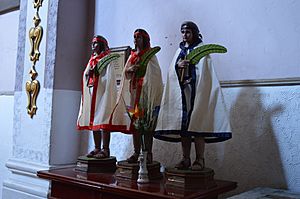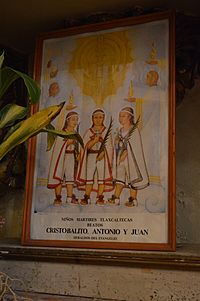Child Martyrs of Tlaxcala facts for kids
Quick facts for kids SaintsCristobal, Antonio and Juan Martyrs of Tlaxcala |
|
|---|---|

Statue of the three children.
|
|
| Martyrs | |
| Born | Cristobal: c. 1514–15 Atlihuetzía, Mexico Antonio: c. 1516–17 Tizatlán, Mexico Juan: Tizatlán, Mexico |
| Died | Cristobal: 1527 Atlihuetzía, Mexico Antonio and Juan: 1529 Cuauhtinchán, Mexico |
| Venerated in | Catholic Church |
| Beatified | 6 May 1990, Basilica of Our Lady of Guadalupe, Mexico City, Mexico by Pope John Paul II |
| Canonized | 15 October 2017, Saint Peter's Square, Vatican City by Pope Francis |
| Feast | 23 September |
| Attributes | Palm Cross |
| Patronage |
|
The Martyrs of Tlaxcala were three young Mexican boys from the state of Tlaxcala. Their names were Cristobal (who lived from about 1514/15 to 1527), Antonio (about 1516/17 to 1529), and Juan (about 1516/17 to 1529).
These three boys changed from their families' traditional beliefs to the Roman Catholic faith. They learned about this new faith from the Order of Friars Minor, also known as Franciscan friars. The friars baptized them and taught them strong religious values. The boys were very eager to share their new faith. Sadly, this led to their deaths by people who did not like their new beliefs.
The three boys were later declared "blessed" (a step towards becoming a saint) in Mexico in 1990 by Pope John Paul II. On March 23, 2017, Pope Francis announced that they would become saints. They were officially made saints on October 15, 2017.
Their Lives
Most of what we know about the Tlaxcalan Child Martyrs comes from a writer named Toribio Benavente Motolinia. He wrote about their lives in 1539. Later, other texts were written in the Nahuatl language by Juan Bautista.
Cristobal
Cristobal was born around 1514 or 1515. His father, Acxotécatl, was an important local leader. Cristobal was expected to take his father's place one day. He had three brothers, Bernardino, Luis, and one whose name is not known. His mother was Tlapaxilotzin, who was his father's first wife.
Cristobal became a Roman Catholic and went to the first school run by the Franciscan friars in Tlaxcala. There, he was baptized and learned a lot about his new faith. The Franciscan friar Motolinia often called him "Cristobalito," which means "little Christopher." At first, his father did not want Cristobal to go to the Franciscan school. But the friars and Cristobal's brothers convinced him.
Cristobal was very enthusiastic about sharing his new faith. He even started removing traditional religious symbols from his home. His father was upset by this. His stepmother also disliked Cristobal's strong faith and urged her husband to stop him.
One day, Cristobal's father became very angry. He hurt Cristobal badly because of his faith. Cristobal died the next morning in 1527 from his injuries. Even as he was dying, he forgave his father. Cristobal's mother also died trying to protect her son.
Cristobal's father tried to hide his son's body. However, he was soon caught and punished for the murder. In 1528, a Franciscan friar named Andrea found Cristobal's remains. He made sure they were properly buried in another place.
Antonio and Juan
Antonio was born around 1516 or 1517. He was the grandson of a respected noble named Xiochténacti. Antonio was expected to be his grandfather's heir. He also became a Roman Catholic. He did not like the traditional rituals of his people. Antonio was a good interpreter for the Franciscan friars.
Antonio and his servant, Juan, were killed in 1529 by people who did not like their new faith. Antonio came out of a room to find Juan already dead. He asked the attackers why Juan was targeted instead of him, since he was the one who had been removing the traditional symbols. The attackers then turned on Antonio, and he also died.
Juan was born around 1516 or 1517. He came from a humble family. He also became a Roman Catholic and worked as Antonio's servant. Juan died at the same time as Antonio in 1529.
The bodies of both boys were thrown off a cliff. But a Dominican friar named Bernardino found them. He moved their bodies to Tepeaca to be buried.
Becoming Saints
The process to make the three boys saints began on January 7, 1982. The Congregation for the Causes of Saints (a special group in the Catholic Church) officially approved the start of their cause. They were then called "Servants of God." A special investigation took place in the Diocese of Tlaxcala, led by Bishop Luis Munive Escobar. Historians later checked the information and found no problems.
A detailed report about their lives and deaths was sent to the Congregation for the Causes of Saints in 1989. Church experts reviewed it and agreed that the boys were killed "in odium fidei." This Latin phrase means "in hatred of the faith." On March 3, 1990, Pope John Paul II confirmed this. He then declared them "blessed" on May 6, 1990, during his visit to Mexico City.
It was later announced that the three boys might become saints. Cardinal Angelo Amato said that Pope Francis was very interested in their story. On March 14, 2017, the Congregation for the Causes of Saints approved their cause. Pope Francis then approved their canonization on March 23, 2017. This meant they could become saints without needing a miracle to be officially recognized. The date for their canonization was set on April 20. The children officially became saints on October 15, 2017.
The person in charge of their cause at the time they became saints was a Franciscan named Giovangiuseppe Califano.
See also
 In Spanish: Niños Mártires de Tlaxcala para niños
In Spanish: Niños Mártires de Tlaxcala para niños


